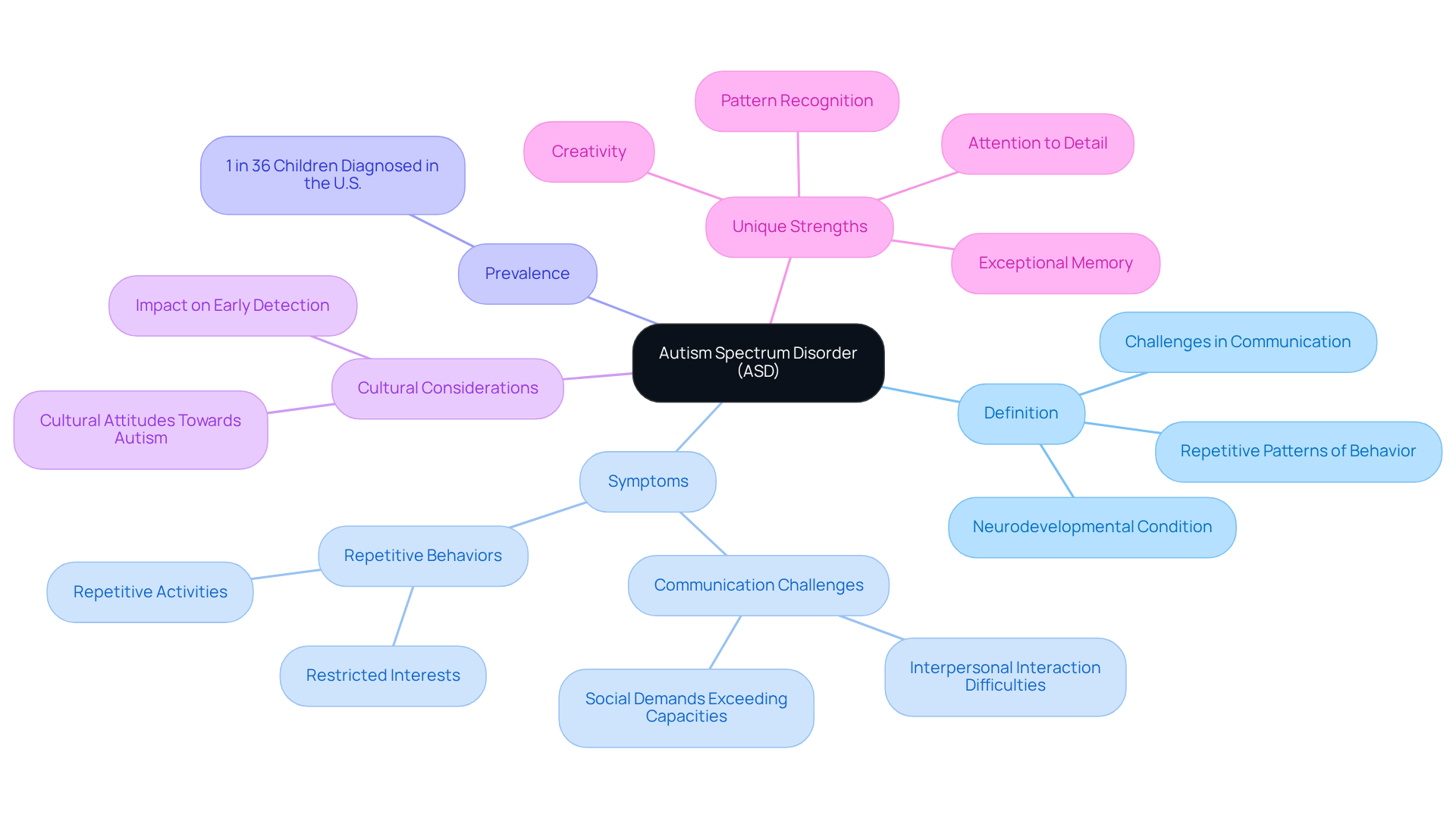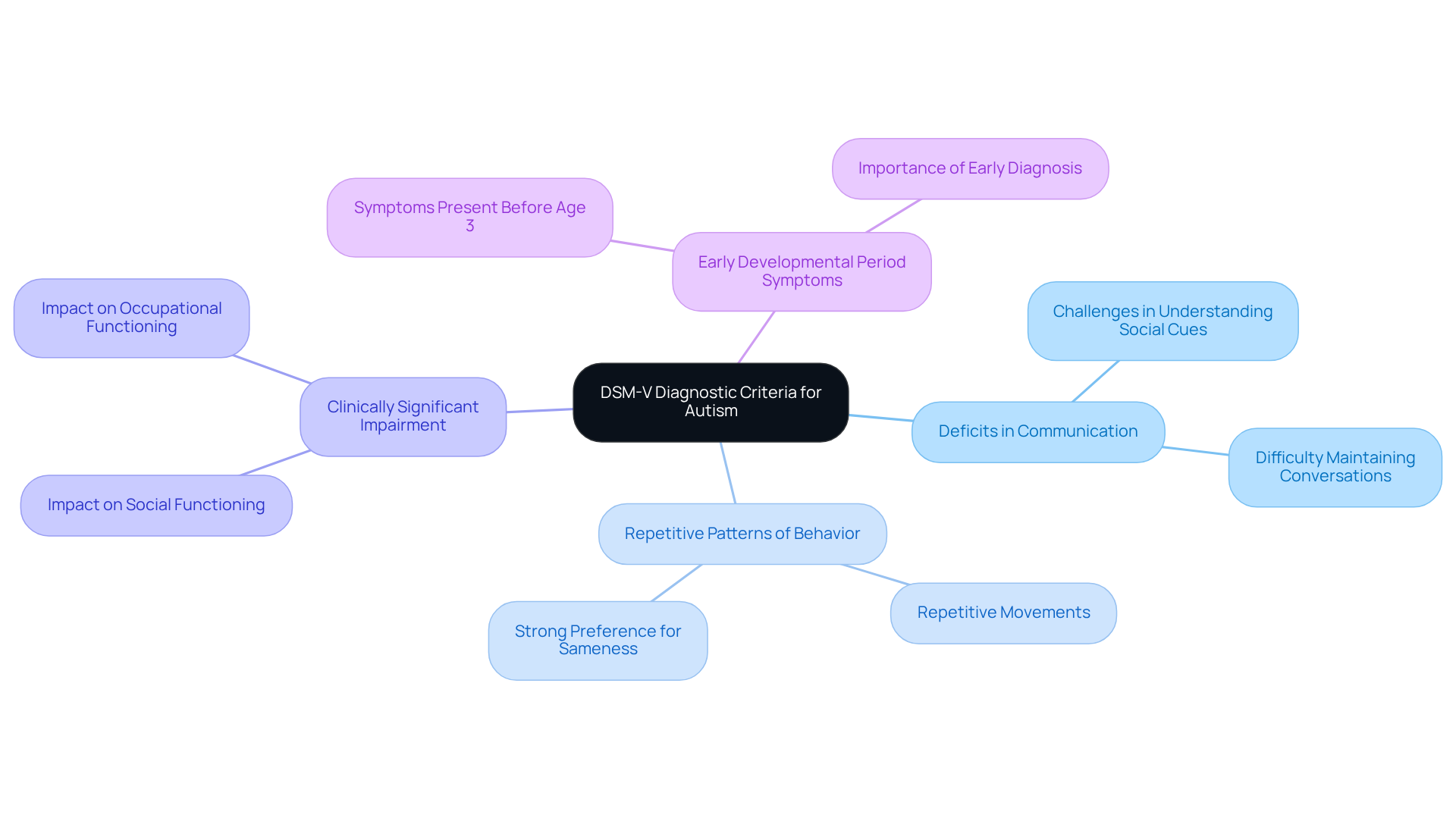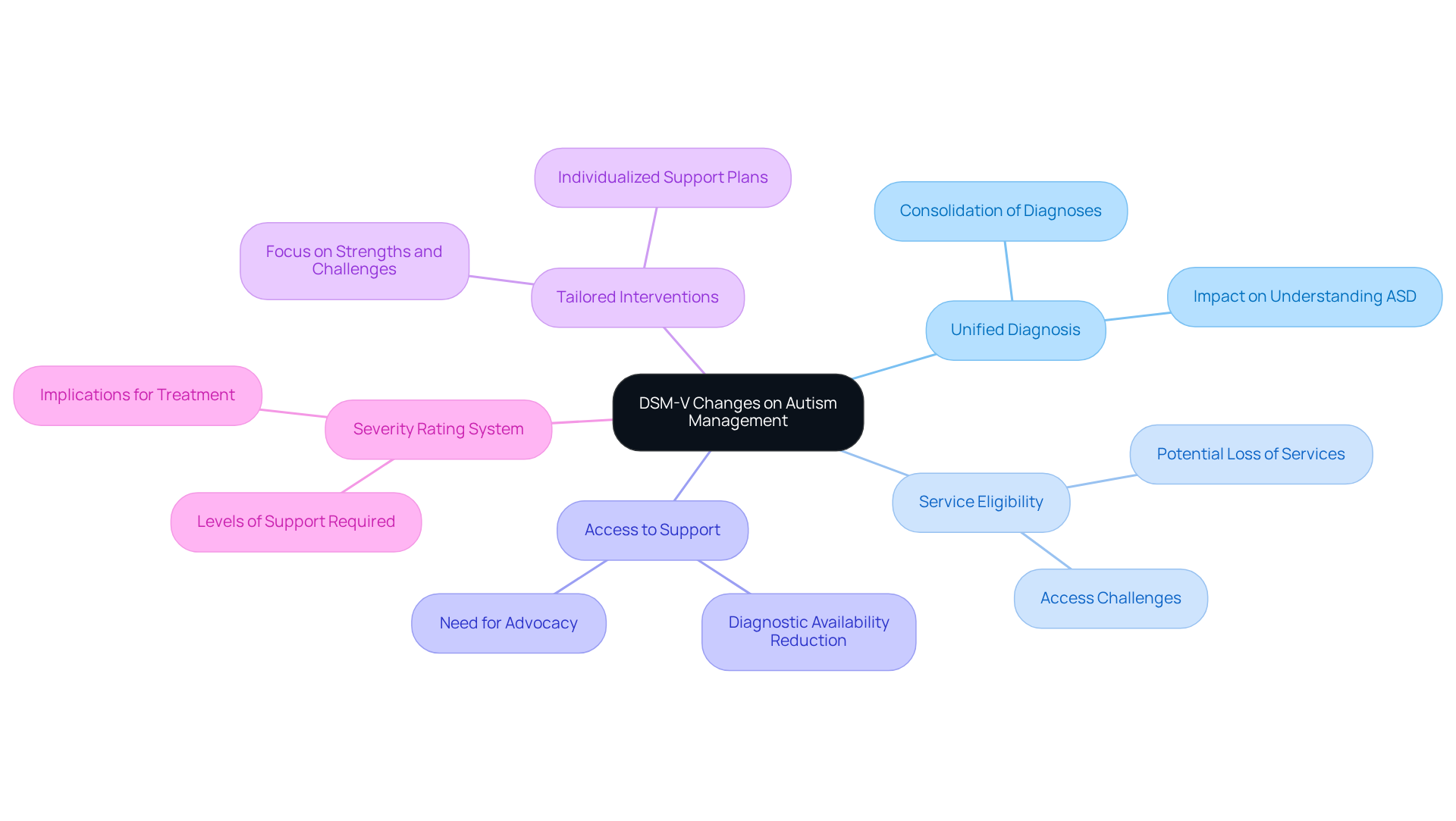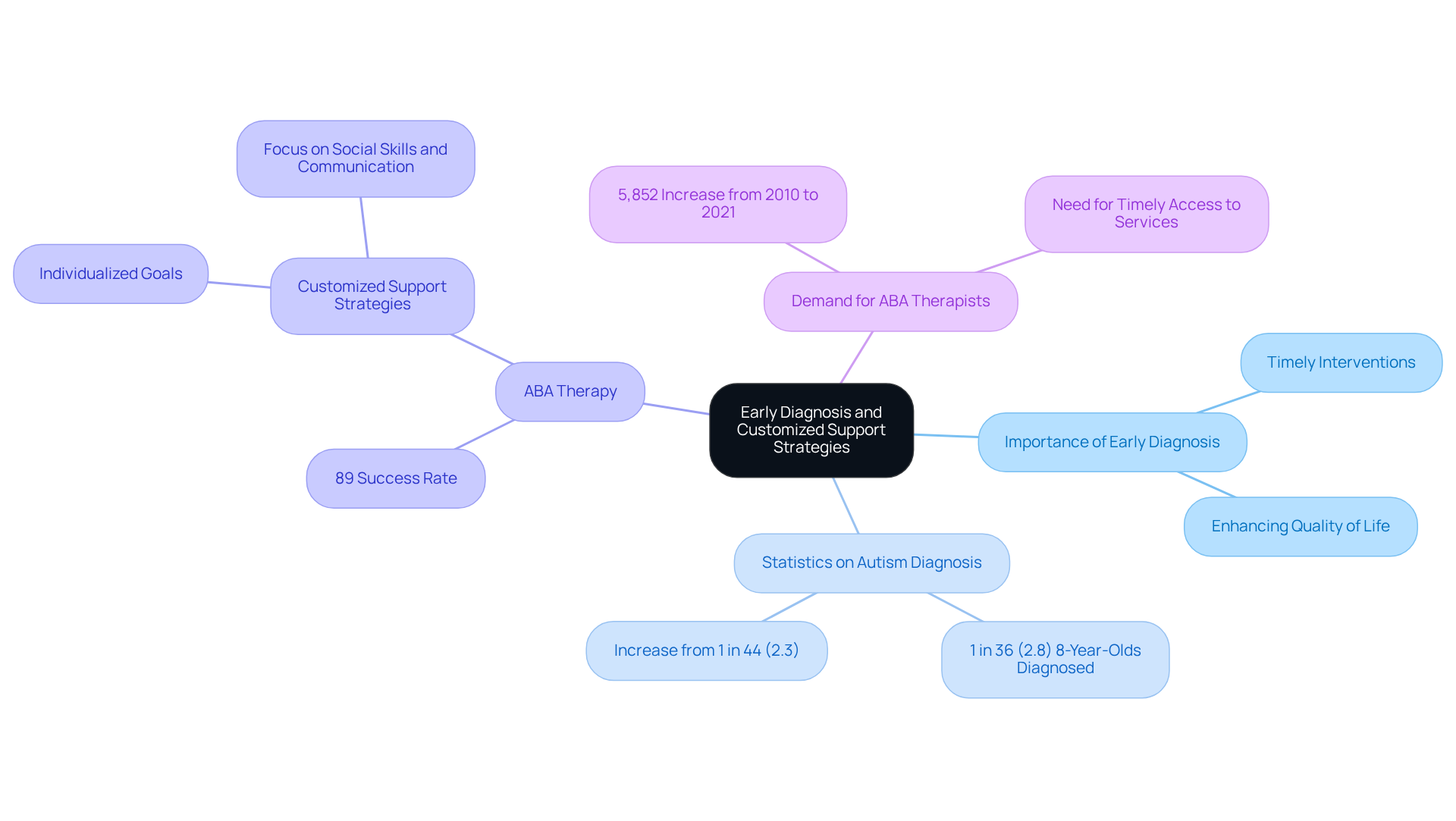Overview
This article shines a light on Autism Spectrum Disorder (ASD) as defined in the DSM-V, offering essential insights that resonate deeply with parents and advocates. It underscores the critical nature of early diagnosis and the need for tailored support, fostering a nurturing environment for families. By recognizing the diagnostic criteria and understanding the shifts from DSM-IV to DSM-V, families can feel empowered to pursue appropriate interventions. This knowledge helps them navigate the often complex landscape of accessing necessary services, ultimately enhancing the outcomes for children with ASD.
Navigating the world of ASD can be daunting, but remember, you are not alone. Many parents share similar experiences and challenges. By connecting with others and utilizing available resources, you can create a supportive network that fosters understanding and growth. Let’s work together to ensure that every child with ASD receives the care and support they deserve.
Introduction
Understanding Autism Spectrum Disorder (ASD) through the lens of the DSM-V is crucial for parents and advocates as they navigate the complexities of this neurodevelopmental condition.
With an alarming 1 in 36 children diagnosed, the DSM-V offers vital insights into the diagnostic criteria that can empower families to recognize early signs and pursue timely interventions.
As the landscape of autism diagnosis evolves, however, many questions arise about access to services and the implications of recent changes in classification.
How can parents effectively advocate for their children amidst these shifting paradigms?
This journey can feel overwhelming, but know that you are not alone. Together, we can explore the resources and support available to help you and your child thrive.
Clarify Autism Spectrum Disorder in DSM-V
The dsm-v autism defines Autism Spectrum Disorder (ASD) as a neurodevelopmental condition marked by ongoing challenges in interpersonal communication and interaction across various contexts, in addition to restricted and repetitive patterns of behavior, interests, or activities. Understanding this definition is vital for parents and supporters, as it equips them to identify the signs and manifestations of developmental disorders in children. The dsm-v autism highlights that these symptoms typically emerge during early development, although they may not be fully evident until social demands exceed a child's limited capacities. This clarity empowers parents to recognize potential concerns early and to seek appropriate evaluations and interventions.
With approximately 1 in 36 children in the U.S. diagnosed with this condition, awareness of these criteria is essential for creating supportive environments and ensuring access to necessary resources. As Dr. Jane Doe, a specialist in developmental disorders, notes, 'The understanding and diagnosis of the disorder have been transformed by DSM-V autism.' Furthermore, recognizing the unique strengths of individuals with ASD, such as remarkable memory and attention to detail, provides a more balanced view of the disorder.
For instance, many parents have noticed signs of developmental disorders in their children through behaviors like intense focus on specific interests or challenges in social interactions, prompting them to seek assessments and support. Understanding these dynamics is especially important given the cultural attitudes that may shape how families perceive and respond to autism. We encourage you to reflect on your experiences and share them in the comments, fostering a community of support and understanding.

Explore DSM-V Diagnostic Criteria for Autism
Navigating the world of Autism Spectrum Disorder can be daunting for parents, but understanding the diagnostic criteria outlined in the DSM-V autism is a crucial first step. These criteria include:
- Persistent deficits in interpersonal communication and interaction, which may manifest as challenges in understanding social cues or maintaining conversations.
- Restricted, repetitive patterns of behavior, interests, or activities, such as repetitive movements or a strong preference for sameness.
- Symptoms that lead to clinically significant impairment in social, occupational, or other important areas of functioning.
- The presence of symptoms during the early developmental period.
By familiarizing themselves with the DSM-V autism criteria, parents can feel empowered to advocate for their children during evaluations, ensuring they receive the essential support and resources they need. Remember, you are not alone in this journey; many parents share similar experiences and challenges. Together, we can foster understanding and provide the best possible outcomes for our children.

Analyze Implications of DSM-V Changes on Autism Management
The transition from DSM-IV to DSM-V has brought about significant changes in how DSM-V autism is classified and diagnosed. Notably, it has consolidated previously distinct diagnoses—such as Asperger's Disorder and Pervasive Developmental Disorder-Not Otherwise Specified—into a unified diagnosis known as Autism Spectrum Disorder (ASD). This change can have profound effects on service eligibility and funding, creating potential obstacles for many young individuals who previously qualified under separate categories in accessing the necessary support they need.
For instance, early estimates suggested a concerning consolidation of as much as 54% in diagnostic availability. This means that countless individuals might experience reduced access to diagnostic services, which can be crucial for their development. The DSM-V autism emphasizes a spectrum approach, fostering a more nuanced understanding of each individual’s unique strengths and challenges. This shift encourages tailored interventions that can significantly enhance outcomes for those with ASD.
However, it’s important to acknowledge the concerns raised by researchers and advocates regarding the potential loss of services for those who may no longer meet the revised criteria. While the changes aim to enhance diagnostic precision, they may unintentionally limit access to essential services for certain young individuals. Moreover, the DSM-V autism has implemented a severity rating system that classifies individuals into three levels based on the degree of assistance required for daily functioning.
Overall, the revisions in the DSM-V call for a thorough reassessment of how services for individuals on the spectrum are provided. It is crucial to ensure that all youth receive the assistance they need to flourish, and that their unique needs are met with compassion and understanding.

Emphasize Early Diagnosis and Customized Support Strategies
Recognizing dsm-v autism early is crucial. It opens the door to timely interventions that can significantly enhance a young person's development and overall quality of life. Did you know that approximately 1 in 36 (2.8%) 8-year-old children are diagnosed with autism? This statistic underscores the importance of proactive assessments by parents who may notice signs of autism, such as challenges in communication or social interactions.
Customized support strategies, particularly Applied Behavior Analysis (ABA) therapy, can be tailored to meet each child's unique needs. This might involve setting individualized goals that focus on social skills, communication, and behavior management. Research shows that early intervention with ABA therapy can lead to improvements in communication abilities, cognition, and a reduction in the severity of dsm-v autism symptoms. In fact, ABA therapy boasts an impressive success rate of over 89% in assisting youth with ASD, highlighting its effectiveness as a personalized support approach.
By working closely with professionals and utilizing available resources—such as family involvement in ABA programs—parents can create a nurturing environment that fosters their child's growth and development. Furthermore, the demand for certified ABA therapists has skyrocketed by 5,852% from 2010 to 2021, emphasizing the urgent need for timely access to therapy services. Addressing the challenges in accessing these services is essential for achieving better long-term outcomes. Together, we can make a difference in the lives of children with ASD and their families.

Conclusion
Understanding the intricacies of Autism Spectrum Disorder (ASD) as defined by the DSM-V is essential for parents and advocates alike. This comprehensive guide sheds light on the diagnostic criteria and underscores the importance of early recognition and tailored support strategies. By grasping these concepts, caregivers are better equipped to navigate the complexities of autism, ensuring their children receive the necessary interventions to thrive.
Key insights from the article highlight the significance of recognizing the symptoms of ASD early, along with the profound impact of the DSM-V changes on diagnosis and service accessibility. The consolidation of previously separate diagnoses into a unified ASD category emphasizes the need for advocacy to ensure that all individuals receive appropriate care. Furthermore, understanding the diagnostic criteria empowers parents, enabling them to effectively advocate for their children's needs.
Ultimately, this article serves as a heartfelt call to action for parents and advocates to engage actively in the autism community. By sharing experiences, seeking timely evaluations, and utilizing evidence-based interventions like ABA therapy, families can significantly enhance the developmental outcomes for children with ASD. The journey may be challenging, but with the right knowledge and support, it is indeed possible to create a nurturing environment where children with autism can flourish.
Frequently Asked Questions
What is Autism Spectrum Disorder (ASD) as defined by the DSM-V?
Autism Spectrum Disorder (ASD) is defined as a neurodevelopmental condition characterized by ongoing challenges in interpersonal communication and interaction, along with restricted and repetitive patterns of behavior, interests, or activities.
When do symptoms of ASD typically emerge?
Symptoms of ASD usually emerge during early development, although they may not be fully evident until social demands exceed a child's limited capacities.
Why is it important for parents and supporters to understand the definition of ASD?
Understanding the definition of ASD helps parents and supporters identify signs and manifestations of developmental disorders in children, enabling them to recognize potential concerns early and seek appropriate evaluations and interventions.
How common is ASD among children in the U.S.?
Approximately 1 in 36 children in the U.S. are diagnosed with Autism Spectrum Disorder.
What are some unique strengths of individuals with ASD?
Individuals with ASD may exhibit remarkable memory and attention to detail, providing a more balanced view of the disorder.
What behaviors might prompt parents to seek assessments for their children?
Parents may notice signs of developmental disorders through behaviors such as intense focus on specific interests or challenges in social interactions, which can lead them to seek assessments and support.
How do cultural attitudes influence perceptions of autism?
Cultural attitudes can shape how families perceive and respond to autism, making it important to understand these dynamics in the context of seeking support and intervention.




